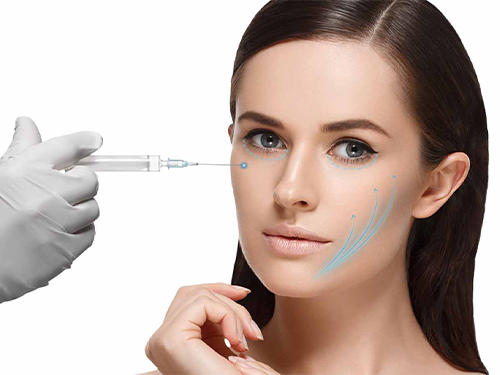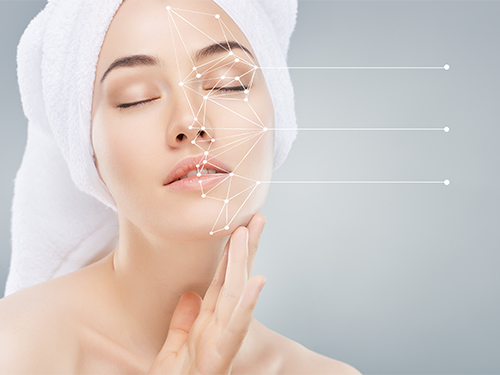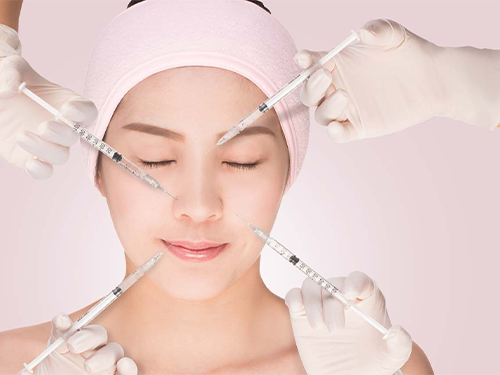Overview
Togglefiller injections
Filler can be a good treatment for the beauty of your skin. Here’s an overview of everything you need to know about filler injections.
Gels and fillers are no longer a mystery, thanks to social media platforms and celebrities who have become more transparent about the beauty practices they have performed.
In the world of medical aesthetics, fillers have become one of the most popular nonsurgical procedures. Dermal fillers are gel-like substances that are injected beneath the skin to:
- stimulate the skin’s natural production of collagen
- plump up and smooth skin
- diminish the appearance of fine lines, wrinkles and other visible signs of aging
- obtain symmetry among facial features
- restore volume to sunken cheeks or temples
- plump & enhance the lips
- raise depressed (atrophic) areas of acne scars
- smooth out a chin crease
- correct flaws of the nose
One thing to note is that dermal fillers are not FDA-approved for body contouring procedures. In other words, they aren’t suitable options to increase the size of your breasts or butt.
Where Are Fillers Used?
Some of the most common areas to inject filler include:
- the wrinkles on the sides of the mouth (also known as laugh lines)
- in the lips
- in the cheeks
- around the eyes
- in the jawline
- in the temples (mostly for clients who have lost a significant amount of weight and their temples become sunken)
- Earlobes (This filler injection can plump up earlobes that are drooping because of piercings and aging)
- Hands
- Nose (in order to correct the flaws to obtain asymmetry)
- Hairline (for a brow lift)
Different Types of Fillers and Their Properties
In general, fillers are categorized by the substances they are made from. Each one of them has unique properties that make them ideal for different aesthetic objectives.
According to the FDA, there are four categories of fillers, including:
- hyaluronic acid (HA)
- calcium hydroxylapatite
- poly-L-lactic acid
- polymethylmethacrylate (PMMA)
Name
Material
Consistency
Longevity of Results
Famous Brands
hyaluronic acid
natural
soft
6-12 months
Juvéderm and Restylane
calcium hydroxylapatite
natural
Thicker than HA
18 months
Radiesse
poly-L-lactic acid
synthetic
Thick
2 years
Sculptra
PMMA
synthetic
Thick
permanent
Bellafill
Injectable Hyaluronic Acid
The most commonly used filler is a compound comprised of hyaluronic acid, which is naturally produced by the body and can be found in your skin and cartilages. This type of filler is used to fill in deep wrinkles and restore volume in areas where it is lost. Thanks to its ability to store moisture, hyaluronic acid is responsible for giving skin a plump and hydrated look. Once injected, it begins to integrate into the skin, absorbing water molecules and hydrating the surrounding tissue.
You must have seen its name in the list of ingredients of various moisturizers. It’s a very safe agent. The texture of HA feels more like real skin, since it is not as thick and concentrated as other types of fillers. The result acquired with HA is temporary, lasting 6 to 12 months before the body gradually and naturally absorbs the particles. This may sound like a drawback, but most people tend to like this aspect because when compared to other types of fillers, it’s reversible and you can choose to dissolve it, just in case you change your mind. Juvéderm and Restylane are two popular brands of hyaluronic acid fillers that you may have heard of.
Injectable Calcium Hydroxylapatite
Calcium hydroxylapatite is also a natural substance, found primarily in our bones. When used as a filler, the calcium particles are nearly microscopic and suspended in a smooth gel. The consistency of a CaHA filler is typically thicker than that of a hyaluronic acid filler and typically lasts longer as well, about 18 months for most clients. Calcium Hydroxylapatite is also reported to help stimulate natural collagen production, and it is typically used for deeper lines and wrinkles. FDA has approved Radiesse as a CaHA filler.
Injectable Poly-L-lactic Acid
Poly-L-lactic acid is a biocompatible (meaning that it is safe to be used in the body) synthetic material that has been used for many years in medical devices, such as dissolvable stitches.
Poly-L-lactic acid products are technically classified as “collagen stimulators,” as their main mechanism to smooth fine lines is by helping your skin rebuild natural collagen—the filler gel itself decomposes a few days after treatment. This type of filler is typically used to treat deeper facial wrinkles, and results can last more than 2 years. FDA has approved Poly-L-lactic acid fillers, including Sculptra.
Injectable Polymethyl Methacrylate
Polymethyl methacrylate is the only filler that can’t be absorbed by your body. Therefore, the results are permanent. They’re only used around the mouth.
Polymethylmethacrylate (PMMA) is a synthetic, biocompatible substance that has been used in medicine for much of the last century. In dermal fillers, PMMA remains beneath the skin indefinitely to provide continued support. PMMA fillers will also contain collagen to provide structure and firmness. FDA has approved PMMA fillers, including Bellafill.
Autologous Fat Injections (Facial Fat Grafting)
Autologous fat injections are the only injectable filler treatment that requires surgery, but results can last for many years. Your own fat is harvested from another area (autologous means “from the same person”), typically using liposuction. The fat is then purified and injected into the face to help restore volume to the cheeks, temples, lower eyelids, or other areas. Fat injections require specialized training to perform safely and achieve great results, and should only be performed by an experienced, board certified cosmetic surgeon.
Results are less predictable because they depend on how much of the injected fat will redevelop a blood supply and survive. About 50 percent will survive and once it does, the fat will stay at its position permanently. But multiple procedures may be necessary to get your desired look, and results can be less predictable.

Which Dermal Filler to Use?
There are many brands of fillers within each category and each product is uniquely formulated to have a certain texture, density, and injection depth, which means that certain fillers work better for certain areas of concern. To give you an example, fillers with larger particles and denser concentration have the ideal properties to rebuild and sculpt facial features. Therefore, they’re better options for sculpting the jawline or thinned cheekbones, for example. While fillers with smaller particles and softer texture work better for addressing fine lines and plumping lips. If you poke around your face, you’ll notice how all those areas naturally feel a little different to the touch.
Many practitioners will look towards the Food & Drug Administration (FDA) in the United States for guidance on filler use and safety. In order for fillers to gain FDA approval, the pharmaceutical company must prove safety as well as efficacy. So, if you are looking for a safe and effective filler, check if it is FDA approved for the area you want treated.
Results
The first step in avoiding undesired results is to begin by injecting temporary fillers. This will enable both the beauty seeker and the physician to evaluate the cosmetic results and decide whether a more permanent filler would be a good idea.
The results after a filler treatment will vary from person to person. Swelling and bruising in the first 3-5 days is normal and common after facial fillers, but generally you will see an immediate difference in volume and shape of the treated area. The results tend to improve as the swelling settles and the filler begins to sit more naturally in the skin. This may take around two weeks. The final result will be obtained at about 4 weeks after the treatment, and you can be reviewed by your doctor to see if further treatments are required to achieve the planned results. Reviewing the injection result prior to 4 weeks is not recommended as there is often a small amount of swelling present, so the results cannot be judged until then. This is particularly important regarding symmetry of the facial features.
It’s important to spend some time discussing possible results with your practitioner to make sure that they understand your goals. Some clients are afraid that they would look “fake” after having filler injections, but as long as it is done by a skilled practitioner, the chances of unnatural results are quite low after only one session. Things can go wrong when people keep adding filler over numerous sessions until their results look disproportionate.
Not Happy with The Results? It’s Not the End of the World!
If you’re unsatisfied with the way your filler looks, don’t panic! In most cases, you can have it adjusted. A dermatologist might inject additional filler to create a balance, or they can dissolve it altogether, depending on the type of filler used. The wonderful thing about hyaluronic acid fillers is that there’s an enzyme that can be injected into the area to dissolve the product. It can be used right away, but doctors always recommend waiting for two weeks before making a decision because it takes time for the swelling to go down. The fillers can take up to two days to fully dissolve after injecting the enzymes.
How Long Do Fillers Last?
How long the filler lasts will depend on the type of filler used, where it was injected and the client. Generally speaking, the denser the product is and the more deeply it is injected, the longer it will last. Fillers in areas with little muscular movement or tension such as temples or jawline tend to last longer; whereas areas with more movement or tension such as the lips, nose and cheeks tend to last less.
Different fillers have different lifespans before your body absorbs and processes it. Each person also “metabolizes” the substances slightly differently. A few types of fillers contain permanent substances that stay in your body sort of indefinitely. Synthetic fillers tend to last longer, as they are not absorbed by the body. They can be a great option for clients who are ready to commit to results that will be present for several years.
Hyaluronic acid fillers tend to be the most temporary option, and therefore are often recommended for first-timers. Some clients prefer hyaluronic acid fillers due to this aspect since it is less risky. Fat injections are meant to last indefinitely; however, some injected fat is expected not to survive. Initially, your cosmetic surgeon may overfill the treatment area, resulting in a fuller look that will gradually settle into a more natural appearance.
Since the majority of fillers aren’t permanent, you’ll have to keep going back to your doctor’s office if you love the results following your procedure. So, you have to get touch-ups once or twice a year to maintain the look.
Face Filler Complications
All dermal fillers are generally very safe, though it is necessary to perform skin testing for allergies prior to the use of any filler with bovine collagen.
There are still minor complications to be aware of, including:
- Swelling
- Bruising
- Itching
- Redness
- Allergic reaction to lidocaine or bovine collagen
- Headache (especially after temple fillers)
Cold sores and dermal filler
There may be a small chance that a treatment may induce an outbreak of facial cold sores in clients with a previous history. Some prefer taking preventative Lysine or antivirals to help reduce the risk of cold sores. If you got cold sores after a treatment, you should see your doctor.
What Are the Risks of Facial Fillers?
The scariest risk, which is extremely rare, is that if an injection strikes one of the arteries that connects to your eye, it can cause blurred vision or blindness. This has been reported to have happened 98 times around the world. You should call your doctor or the emergency room if your skin turns blue, and you’re in a lot of pain—these are two possible signs that filler is in your bloodstream.
Fillers for Acne Scars
In this treatment, a filler is injected directly into acne scars with a very small needle to temporarily improve the skin’s appearance. Dermatologists may choose various fillers to operate this therapy, but Bellafill is the only FDA-approved filler to treat moderate to severe, atrophic facial acne scars for patients aged 21 or older.

Benefits, Risks and Complications
Fillers offer a temporary method of smoothing acne scars that are relatively inexpensive and minimally invasive. The new generation of fillers are based on substances naturally found in human skin. Therefore, allergic reactions are extremely rare. Most of the complications are what you would expect from a needle injection, like bruising, swelling, redness, itching and pain.
Procedure of Fillers for Acne Scars
About a month prior to your appointment, you are asked to take part in an in-office allergy test to make sure you’re not allergic to bovine collagen if the filler you are using contains it. In the test, the collagen will be injected into your forearm, and you will remain at the office to be monitored for any reaction. If you are not allergic or if your filler does not contain bovine, you will be able to proceed with your treatment.
On the day of the injection, after your skin is cleaned, your doctor will likely mark your face so that they know exactly where to inject. Each syringe of filler contains lidocaine, a numbing agent that makes the procedure less painful. Depending on the depth of the scars and the size of the area, the procedure can take anywhere from 15 minutes to about an hour.
What to Expect After the Procedure?
Most fillers are temporary, lasting anywhere from six months to two years, depending on the filler and type of procedure. Some patients require follow-up treatments to maintain the best results. Some people with severe acne scarring may need more than one treatment to see full results.
With most treatments, downtime is minimal; you can resume most activities right away, and you should be able to drive yourself home. It is recommended to avoid strenuous activities, itching or rubbing the injection site in the first three days after treatment.
Using Bellafill to Treat Acne Scars
The collagen in Bellafill adds volume and lifts the skin, making indented scars look less noticeable. Eventually, the collagen will be reabsorbed into the body. This provides structure and support to the skin and allows for more collagen to develop.
The skin stays smooth for a longer period of time when compared to other fillers. Bellafill will generally last around 12 months for acne scars.
Using Other Types of Fillers for Acne Scars
Hyaluronic Acid
In some cases, hyaluronic acid fillers, like Juvederm or Restylane, may be used to treat acne scars. These fillers can improve the contour of the skin and reduce the depressions in the skin caused by acne scars. When compared to Bellafill, these fillers are considered temporary and will need to be injected every few months.
Poly-L-lactic acid
Another type of filler, Poly-L-lactic acid (Sculptra), is sometimes used as well. This substance is not like other fillers since it won’t immediately plump your skin. Instead, it stimulates your skin’s production of collagen to gradually reduce the appearance of acne scars over a few months.
You’ll likely need treatments every month for three months to see desired results. After that, you may need occasional touch-ups, but this filler is considered semi-permanent.
Autologous fat transfer
This procedure is much more in-depth than your standard filler, as fat is harvested from your body to be injected into your acne scars. Results are less predictable because they depend on how much of the injected fat will redevelop a blood supply and survive. Therefore, multiple treatments may be needed to get your desired look.
Who Can’t Get Facial Fillers?
According to the FDA, there’s no research showing that dermal fillers are safe for pregnant or breastfeeding ladies, so you may want to wait if you’re expecting a baby or recently had a child. Another thing to consider is avoiding filler injections right before a teeth cleaning or other dental treatments. These procedures require pressure and stretching of the face that could potentially misplace fillers. During your consultation, you can ask your doctor for their opinion regarding future dental work.
The risks are pretty minimal, but you should avoid fillers if you:
- have an active skin infection at the time of injection
- are pregnant or breastfeeding
- have allergy/hypersensitivity to the filler
- have Glabellar Necrosis
- are allergic to lidocaine, collagen, hyaluronic acids or Artefill
How much do fillers cost?
This can vary depending on many factors such as where you get it done, where on your body you are getting treated, the type of product and amount of product being used and how complex the area you’re getting treated is.
If the price seems too good to be true, it probably is. If you see a deal for inexpensive filler, be skeptical.

Choosing a Provider for Filler Treatments
It is needless to say that if you are having someone injecting fillers into your face, you want to go with a credible injection specialist. Whomever you choose, make sure your provider has a proven background in cosmetic medicine, as well as training and substantial experience performing filler injections. Ask to see before & after photos of a potential provider’s patients. If a registered nurse or physician’s assistant will be performing your injections, that person should be working closely under the supervision of a qualified physician, preferably a board certified cosmetic surgeon.
Before The Procedure
How to Prepare?
At your consultation appointment before the injection session, your dermatologist will review your medical history. This is the time to discuss expectations, potential risks and outcomes of the procedure. You should inform your doctor if you have recently taken:
- Prescription medicines
- Over-the-counter medicines
- Herbal supplements
In order to reduce the chance of bruising and swelling at the injection site, here are a number of recommendations on how to prepare for your appointment:
One Week Prior to Injections
- Avoid blood thinning over-the-counter medications such as aspirin, Motrin, ibuprofen, and Aleve.
- Avoid supplements, primrose oil, garlic, ginseng, and vitamin E.
2 Days Prior to Injections
- Avoid skincare topical products such as Tretinoin (Retin-A), Retinol, Retinoids, Glycolic Acid, or any “anti-aging” products.
- Avoid waxing, bleaching, tweezing, or using hair removal cream on the area that is to be treated.
24 Hours Prior to Injections
- Do not drink alcoholic beverages
If you have previously suffered from facial cold sores, there is a risk that the needle punctures could contribute to another eruption of cold sores. Please let your physician know if you are prone.
Right before the treatment, your skin will be cleaned, and you may be given a topical anesthetic to numb the area prior to injection. Many filler products also contain lidocaine, a mild anesthetic, which is intended to reduce the pain. Your provider will then inject a precise amount of filler strategically beneath the skin.
After The Procedure
What to Do After Fillers?
The First 24 Hour
- Apply an ice pack on the injected area (along with gentle but firm pressure)
- If necessary, take acetaminophen to reduce pain
- Avoid itching, massaging, or picking around the injection site. The urge to do so is normal and generally disappears within a few hours to a few days. If these symptoms last more than 3 days, please contact your doctor.
- Until the swelling and redness have resolved, avoid intense heat on the treated area(s). This includes sunbathing, tanning, saunas, hot tubs, or hot wax.
- If there is a visible bump, you may gently massage the area.
- Depending on the areas treated, and the product used, you may feel “firmness” which will soften and settle within 1-2 weeks.
- Sunscreen and makeup can be applied, and you may use a gentle cleanser on the area.
- Avoid drinking alcohol or taking part in strenuous exercise, as it may result in additional bruising.
- To help alleviate bruising, we recommend eating fresh pineapple.
First Three Days After Treatment
- Exaggerated and repeated movements should be minimized during the first 3 days after a treatment to minimize filler displacement.
- Avoid pressure on the treated areas for the first few nights (i.e. sleep on back of possible)
PLEASE CONTACT YOUR DOCTOR IMMEDIATELY IF YOU:
- Have fever and/or chills
- Have discolored blotches in areas not injected
- Have blanching of injected areas
- Notice the area appears red and/or hot to the touch
- Have severe or increasing pain
Lip Filler After Care
Lip dermal filler aftercare needs a special mention: When the lips are injected, the upper lip tends to swell much more than the lower lip and often patients think that their upper lip has had too much filler injected into it. Once the swelling calms down, they realize this is not the case. The typical ratio that most people choose for their lip proportion is 40% in the upper and 60% in the lower, so most likely the upper lip is going to be smaller than the lower lip once the swelling resolves (unless the beauty seeker has asked for a less natural-appearing lip).
Why Smart Behan?
Smart Behan is the main platform to provide medical information to address your health issue. Our network introduces best hospital and centers in iran offering high quality services and expert Best Doctors and Surgeons in Iran as well as booking appointment. You can manage your medical travel. Smart Behan accompanies you from airport to airport handling Welcoming, transportation, translation, medical treatment and last not the least follow up when you are back to home.
Smart Behan can also make an appointment with our Primary Skin Care, Dr.Samira Niroumandi Jahromi And Dr.Raheleh Nazari, for your consultation and surgery.
To view the rest of our training posts, you can click here



2 Comments
Tyrone
Wonderful post however I was wanting to know if you could
write a litte more on this topic? I’d be very grateful
if you could elaborate a little bit further. Bless you!
liyan
How long does the filler last?